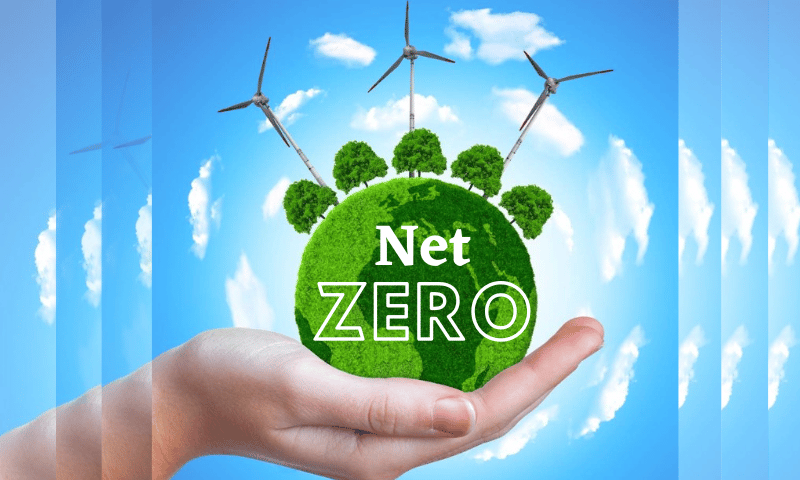In Short : “Decoding net-zero: Unveiling the global pursuit to attain carbon neutrality, this comprehensive narrative explores the collective race to balance our carbon footprint, highlighting the urgent efforts to mitigate climate change through sustainable practices and emissions reduction strategies worldwide.”
In Detail : Imagine a world where the greenhouse gases we emit – the culprits behind climate change – are sucked back into the atmosphere by natural and technological solutions, leaving our carbon footprint as light as a feather.
This is the ambitious dream of net-zero, a state where our emissions are balanced by removals, creating a climate-neutral future.
But what exactly does net-zero mean, and how are we racing towards it? This article breaks down the science, explores the history, and delves into the practical steps being taken to achieve this monumental goal.
The Carbon Equation
Our planet’s delicate balance relies on a natural greenhouse effect, where certain gases trap heat, keeping the Earth habitable.
However, human activities like burning fossil fuels are releasing these gases at an unprecedented rate, causing the planet to warm faster than ever before. This has dire consequences, from rising sea levels and extreme weather events to mass extinctions and disrupted ecosystems.
Enter net-zero: a state where the total amount of greenhouse gases emitted into the atmosphere is balanced by the amount removed.
This doesn’t mean we can’t emit anything; it’s about minimizing emissions through drastic cuts and utilizing natural and technological solutions to remove the remaining ones. Think of it like a budget: we can’t spend more than we earn; in this case, we can’t release more greenhouse gases than we can remove.
The concept of net-zero isn’t new. The scientific community has been warning about the dangers of climate change for decades, and the need for drastic action has been bubbling up in international agreements since the 1990s.
The Kyoto Protocol and the Copenhagen Accord laid the groundwork, but it was the 2015 Paris Agreement that truly put net-zero on the global agenda.
This landmark treaty set the ambitious goal of limiting global warming to well below 2°C, preferably 1.5°C, compared to pre-industrial levels. Achieving this goal, scientists say, is only possible through a rapid transition to a net-zero world by mid-century.
The Net-Zero Toolkit
Governments, businesses, and individuals worldwide are now actively pursuing net-zero goals. Countries are setting ambitious targets, with many committing to achieve net-zero emissions by mid-century or earlier.
For instance, the European Union has set a goal to become climate-neutral by 2050, and China has pledged to reach net-zero emissions by 2060. Even major corporations like Microsoft, Google, and Apple are making substantial commitments to achieve net-zero emissions within the next few decades.
So, how do we get there? The path to net-zero requires a multi-pronged approach. Here are some key areas of action:
Renewable Energy Revolution: Fossil fuels must be replaced with clean energy sources like solar, wind, and geothermal. This transition requires significant investments in renewable energy infrastructure and smart grids to manage the intermittent nature of these sources.
Energy Efficiency: We need to use less energy in the first place. This involves improving building efficiency, adopting energy-efficient appliances, and opting for sustainable transportation choices like public transit, cycling, and walking.
Industrial Transformation: Industries like steel, cement, and chemicals are major emitters. Switching to cleaner production processes, using recycled materials, and adopting carbon capture and storage technologies are crucial steps towards decarbonization.
Natural Solutions: Protecting and restoring forests, mangroves, and other ecosystems can significantly enhance their ability to absorb CO2. Sustainable land-use practices like regenerative agriculture can also contribute to carbon sequestration.
Technology Innovation: Research and development in areas like carbon capture and storage, green hydrogen production, and direct air capture technologies will play a vital role in removing emissions from the atmosphere.
Net-Zero: Challenges, Criticisms, and Opportunities
While the goal of net-zero is clear, the path is full of challenges. Critics point to the immense technological and infrastructural hurdles, particularly in decarbonizing heavy industries like steel and cement. They also point to the financial burden, potential job losses in fossil fuel-dependent sectors, and the reliance on unproven technologies like carbon capture.
Additionally, ensuring a just transition that doesn’t burden vulnerable communities is critical.
However, the opportunities are equally compelling. Net-zero can spur innovation in green technologies, create millions of new jobs in renewable energy and sustainable sectors, and lead to cleaner air and improved public health. Moreover, it paves the way for a future resilient to climate change, protecting our planet and its inhabitants.
The key lies in addressing challenges head-on with international cooperation, strategic investments, and a focus on social justice. Ultimately, achieving net-zero is not just about mitigating climate change; it’s about building a cleaner, healthier, and more equitable future for all.
Net-Zero for Individuals: Small Steps, Big Impact
Reaching net-zero isn’t just a global effort; it’s a personal journey! Here are some ways you can embrace the concept in your daily life:
Power Up the Greens: Choose renewable energy options for your home, advocate for clean energy policies, and support businesses committed to sustainability.
Travel Mindfully: Walk, bike, or use public transportation whenever possible. When driving, opt for fuel-efficient vehicles or carpool.
Eat Greener: Reduce meat consumption, choose local and seasonal produce, and compost food scraps to minimize waste.
Energy Savvy: Switch to LED bulbs, upgrade appliances to energy-efficient models, and adopt low-energy habits like air-drying clothes.
Reduce, Reuse, Recycle: Buy less, mend and repurpose items, and embrace responsible waste management practices.

